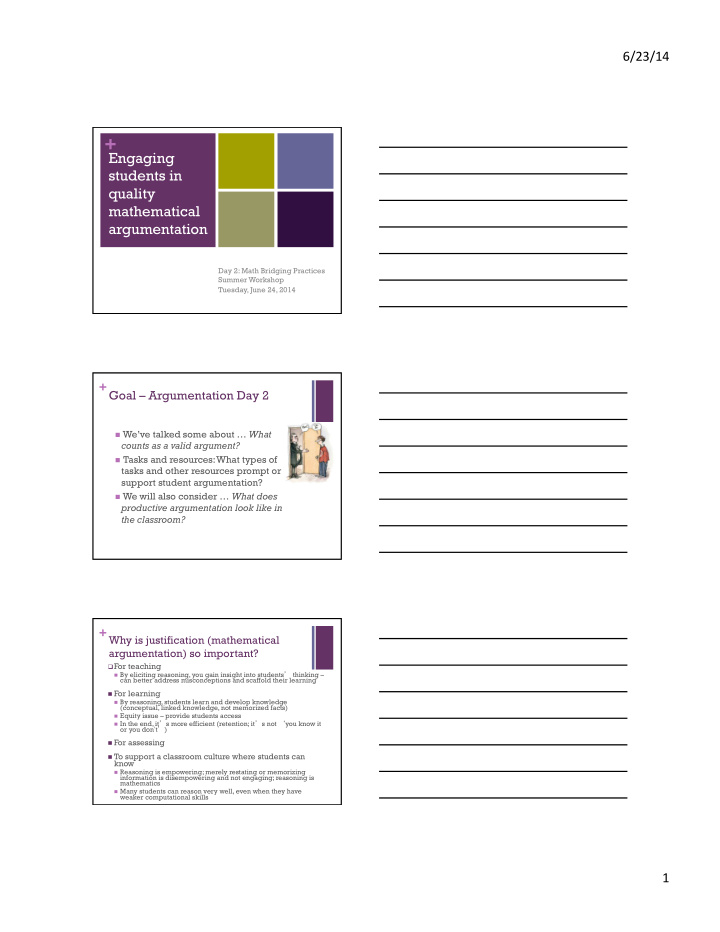



6/23/14 ¡ + Engaging students in quality mathematical argumentation Day 2: Math Bridging Practices Summer Workshop Tuesday, June 24, 2014 + Goal – Argumentation Day 2 n We’ve talked some about … What counts as a valid argument? n Tasks and resources: What types of tasks and other resources prompt or support student argumentation? n We will also consider … What does productive argumentation look like in the classroom? + Why is justification (mathematical argumentation) so important? q For teaching n By eliciting reasoning, you gain insight into students ’ thinking – can better address misconceptions and scaffold their learning n For learning n By reasoning, students learn and develop knowledge (conceptual, linked knowledge, not memorized facts) n Equity issue – provide students access n In the end, it ’ s more efficient (retention; it ’ s not ‘ you know it or you don ’ t ’ ) n For assessing n To support a classroom culture where students can know n Reasoning is empowering; merely restating or memorizing information is disempowering and not engaging; reasoning is mathematics n Many students can reason very well, even when they have weaker computational skills 1 ¡
6/23/14 ¡ + Tasks and Questions n What’s so important about Tasks and Questions?? + What will happen next… + Of course, it’s not a one-to-one correspondence… 2 ¡
6/23/14 ¡ + Task/Resource Sorting Activity Review of tasks and resources Guiding question: n If a student does what is asked of him or her by the task, or uses the resource to guide his or her work (with reasonable interpretation), will s/he engage constructing viable arguments and/or critiquing the reasoning of others ? + Task/Resource Sorting Activity Three categories: Likely to support/engage in cva and cro Potentially will support/engage… Unlikely to support/engage… + Sample 1 n Train A leaves the station traveling due east at 90 mph at 9am. Train B leaves the station traveling due west at 70 mph at 10am. … 3 ¡
6/23/14 ¡ + Sample 1 n Train A leaves the station traveling due east at 90 mph at 9am. Train B leaves the station traveling due west at 70 mph at 10am. How far apart are the trains at noon? n Train A leaves the station traveling due east at 90 mph at 9am. Train B leaves the station traveling due west at 70 mph at 10am. How far apart are the trains at noon? Show your work. n Train A leaves the station traveling due east at 90 mph at 9am. Train B leaves the station traveling due west at 70 mph at 10am. How far apart are the trains at noon? Explain how you know. + Sample 2 Writing in math Student Journal Prompt: Josie thinks that the quadratic equation x 2 + 4x + 6 has no roots because you cannot factor x 2 + 4x + 6. n You’re not so sure. Check Josie’s claim and decide for yourself. + Your task n Think: Review the tasks/resources on the Handout - Private Think Time for ~5 minutes. There’s a set of categories Table # Focal task with descriptors you can use for reference as well. These are meant to 1 A & D guide; not be complete rules. 2 B & E 3 C & A n Pairs-Share: with a partner at your 4 D & B table, review the tasks/resources. Take 5 E & C turns being the first to offer your thoughts on the task or resource. 6 A & D Person with the closest birthday 7 B & E should go first and be prepared to 8 C share group’s thinking . (~10 mins) n Full Group Discussion 4 ¡
6/23/14 ¡ + INSERT SLIDES OF EACH TASK/ RESOURCE + We understand… What are our take-aways? n Implications for when you design tasks or resources? n Implications for your work with students? n What was clarified? Lingering questions? + Argumentation in action Video – 7 th grade math class Fractions 5 ¡
6/23/14 ¡ + The Pr Prompt mpt On first glance, how would you rate the cognitive challenge of this task? + The Pr Prompt mpt CH: “Without doing a rule that you know, like, see if you can make sense of why, what one divided by two-thirds is.” + Argumentation in action n Arguments/justifications unfold as part of the math class. n Cathy Humphrey’s video – 15 mins n From book Connecting Mathematical ideas: Middle School Video Cases to Supporting Teaching and Learning (Boaler & Humphreys, 2005). Heineman Press. 6 ¡
6/23/14 ¡ + Pr Prior to the Video n The teacher talked to her students about her goals for the class—that is, to learn what they understood about division, not just what they could do . n 7 th -grade class. Some know “the rule” and others don’t. Students drawn from “upper” 50% of students. n For each problem, she asked the students to do two things: Decide without paper or pencil what they think the 1. answer is Try to explain why their answer makes sense 2. n Already discussed 1/(1/3), so she thought this would be straightforward. + While Watching • What is the claim being discussed? • What are the arguments that students are making? (Try to mark each argument on your transcript.) • What is the teacher doing to support (or hinder) students’ engagement with argumentation? • Watch for “talk moves” or other pedagogical moves • What are the students doing that support (or hinder) argumentation? Let’s ... 7 ¡
Recommend
More recommend